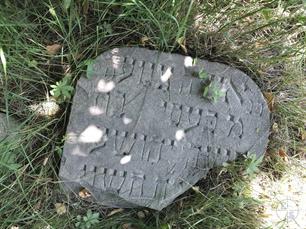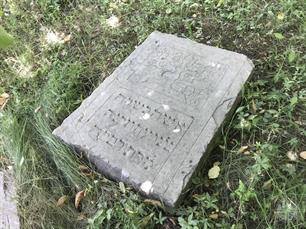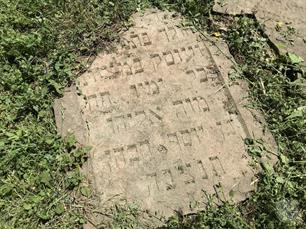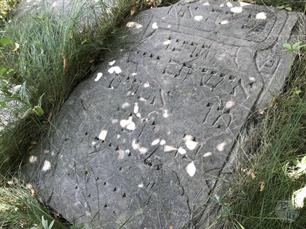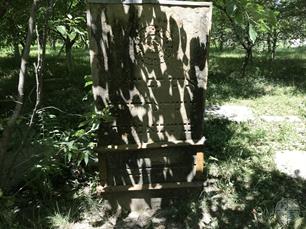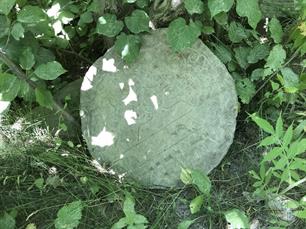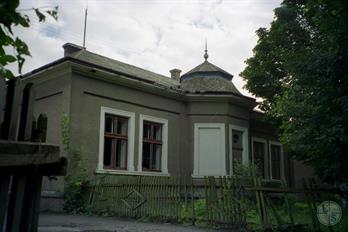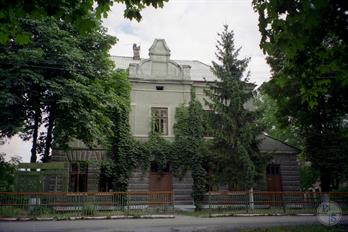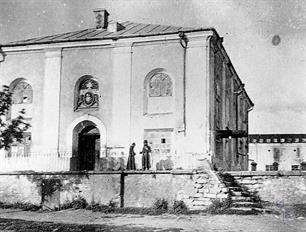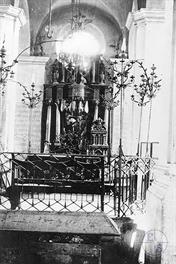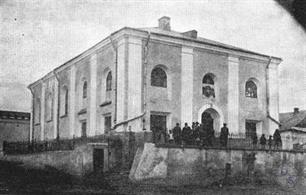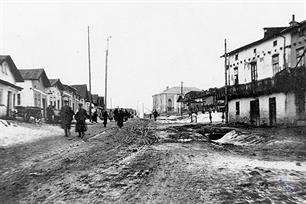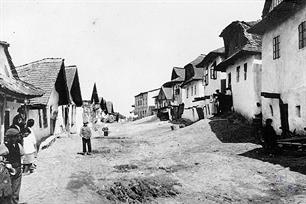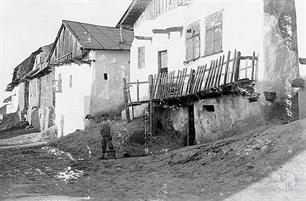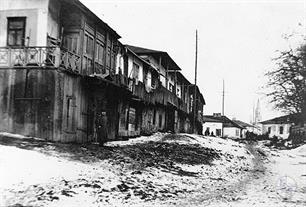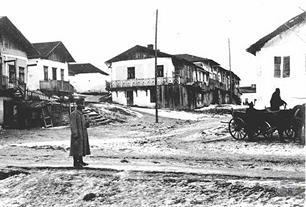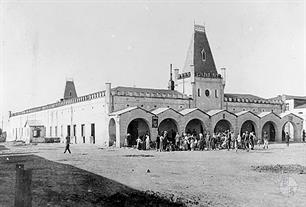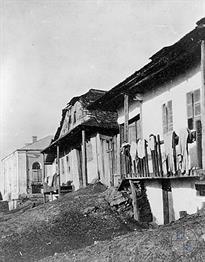Khorostkiv
Chortkiv district, Ternopil region
Sources:
- Pinkas Hakehillot Polin: Encyclopedia of Jewish Communities, Poland, Volume II, page 418, published by Yad Vashem, Jerusalem. Translated by Sidney Lightman, JewishGen, Inc.
Photo:
- Benjamin Lukin (1995), Hryhoriy Arshynov (2019) - Center for Jewish Art, Khorostkiv
- George J. Anker* (1917). Photos submitted by Robert Latzer and Andrew Tanenbaum
* George J. Anker was born in 1885 in Danzig and died in Los Angeles in 1955. He was a lieutenant in the German army during WWI (one of the few German-Jewish officers) and earned the iron cross three times. He spent Winter 1917-18 in Galicia. His hobby was photography and he took photos of the areas he was stationed in and fought in.
- Pinkas Hakehillot Polin: Encyclopedia of Jewish Communities, Poland, Volume II, page 418, published by Yad Vashem, Jerusalem. Translated by Sidney Lightman, JewishGen, Inc.
Photo:
- Benjamin Lukin (1995), Hryhoriy Arshynov (2019) - Center for Jewish Art, Khorostkiv
- George J. Anker* (1917). Photos submitted by Robert Latzer and Andrew Tanenbaum
* George J. Anker was born in 1885 in Danzig and died in Los Angeles in 1955. He was a lieutenant in the German army during WWI (one of the few German-Jewish officers) and earned the iron cross three times. He spent Winter 1917-18 in Galicia. His hobby was photography and he took photos of the areas he was stationed in and fought in.
The little town of Chorostkow (ukr. Khorostkiv, Хоростків) is located between Hosyatin and Kupiczinze, on the banks of the River Taina, in a highly fertile region of Galician Podolia, and does not have a very long history. We learn from an order promulgated in 1748 by Cardinal Mikulai Wyzycki that an independent parish existed in Chorostkow as early as the beginning of the 17th century, and the villages of Chalupowka, Greater Howilow, Lesser Howilow, Karaczinze, Kalubinze, Meshaniecz, Prembilow, Ubisla and Viaczchubtza were linked with it.
In the second half of the 18th century, the land-owner, Siamianski, granted the village the rights of a small town, while abrogating to himself the licensing rights to which every town and small town was entitled. In order to develop the town, Siamianski invited Jewish artisans and merchants from other Podolian towns to come and live there, granting them rights which guaranteed their economic existence, as well as their existence as an independent community. But there was still no independent congregation or cemetery in the town. Chorostkow became affiliated to the congregation in Strusow, 8 or 9 kilometres away, which was linked at that time with the Trembowla District, and that was where the Jews of Chorostkow, who came under the authority of the Rabbi of Strusow, buried their dead. Later on, the town's dead were buried Sochostow, on the main road some 9 kilometres from Chorostkow.
The first group of Jews transferred to Chorostkow from other parts of Podolia during the latter half of the 19th century appointed four men to lead them, headed by Yaakov Feffer. Siamianski invited them to build up the town to serve as a commercial centre for his numerous estates and agricultural produce. He himself built houses for the Jews in the town, which was his private property under Polish law, and put Feffer, an energetic and forceful man, in charge. Feffer paid Siamianski a fee for allowing him to take over the licensing rights.
Thanks to his initiative, the Jewish settlement grew substantially. According to a census carried out in 1765, there were 42 Jewish poll-tax payers and two children less than one year old in Chorostkow. In the Trembowla District as a whole, there 7,534 Jews at that time.
The congregation's organisational arrangements remained unchanged until the period of Austrian rule at the end of the 18th century, when Chorostkow was recognised as a congregational unit, although not as an independent congregation.
Thanks to Yaakov Feffer's efforts, Baron Siamianski helped them to build a large synagogue, where the settlers established a beit hamedrash. Some years later, the tailors established a beit hamedrash of their own. However, the Austrian authorities turned on the Jewish community in 1785, accusing them of having built the synagogue without a Government licence. An order was issued in Vienna that those responsible for building the synagogue were to be punished, even though they had not known about the law or that the responsibility lay with the heads of the community, because it was they who had acted in contravention of the law.
Most of the Jews were pedlars who used to hawk their goods round the town and barter them with the peasants for farm produce. There was also a substantial number of Jewish tradesmen, especially tailors, most of whom worked for Jewish and nonJewish customers in the town itself, while some used to travel round the neighbouring villages, repairing clothes in exchange for produce or poultry, which they then used to sell in the cities. During the time of the Austrians, the Jews played an important role in forestry and the timber industry, selling timber to Danzig.
As far as we know, the first rabbi in Chorostkow Jewry's history was Rabbi David Shlomo Eibeschitz, who was subordinate to the Regional Rabbi in Chortkow. In 1796, while still a rabbi in Bodzanow, Rabbi Eibeschitz helped to reconstitute the Chevrah Kadisha (Burial Society). The fact that there had once been a Chevrah Kadisha in Chorostkow shows that there must also have been a cemetery there at an earlier date.
In the second half of the 18th century, the land-owner, Siamianski, granted the village the rights of a small town, while abrogating to himself the licensing rights to which every town and small town was entitled. In order to develop the town, Siamianski invited Jewish artisans and merchants from other Podolian towns to come and live there, granting them rights which guaranteed their economic existence, as well as their existence as an independent community. But there was still no independent congregation or cemetery in the town. Chorostkow became affiliated to the congregation in Strusow, 8 or 9 kilometres away, which was linked at that time with the Trembowla District, and that was where the Jews of Chorostkow, who came under the authority of the Rabbi of Strusow, buried their dead. Later on, the town's dead were buried Sochostow, on the main road some 9 kilometres from Chorostkow.
The first group of Jews transferred to Chorostkow from other parts of Podolia during the latter half of the 19th century appointed four men to lead them, headed by Yaakov Feffer. Siamianski invited them to build up the town to serve as a commercial centre for his numerous estates and agricultural produce. He himself built houses for the Jews in the town, which was his private property under Polish law, and put Feffer, an energetic and forceful man, in charge. Feffer paid Siamianski a fee for allowing him to take over the licensing rights.
Thanks to his initiative, the Jewish settlement grew substantially. According to a census carried out in 1765, there were 42 Jewish poll-tax payers and two children less than one year old in Chorostkow. In the Trembowla District as a whole, there 7,534 Jews at that time.
The congregation's organisational arrangements remained unchanged until the period of Austrian rule at the end of the 18th century, when Chorostkow was recognised as a congregational unit, although not as an independent congregation.
Thanks to Yaakov Feffer's efforts, Baron Siamianski helped them to build a large synagogue, where the settlers established a beit hamedrash. Some years later, the tailors established a beit hamedrash of their own. However, the Austrian authorities turned on the Jewish community in 1785, accusing them of having built the synagogue without a Government licence. An order was issued in Vienna that those responsible for building the synagogue were to be punished, even though they had not known about the law or that the responsibility lay with the heads of the community, because it was they who had acted in contravention of the law.
Most of the Jews were pedlars who used to hawk their goods round the town and barter them with the peasants for farm produce. There was also a substantial number of Jewish tradesmen, especially tailors, most of whom worked for Jewish and nonJewish customers in the town itself, while some used to travel round the neighbouring villages, repairing clothes in exchange for produce or poultry, which they then used to sell in the cities. During the time of the Austrians, the Jews played an important role in forestry and the timber industry, selling timber to Danzig.
As far as we know, the first rabbi in Chorostkow Jewry's history was Rabbi David Shlomo Eibeschitz, who was subordinate to the Regional Rabbi in Chortkow. In 1796, while still a rabbi in Bodzanow, Rabbi Eibeschitz helped to reconstitute the Chevrah Kadisha (Burial Society). The fact that there had once been a Chevrah Kadisha in Chorostkow shows that there must also have been a cemetery there at an earlier date.
During the period of Austrian rule, Chorostkow's position was the same as that of other communities in Galicia as regards taxes and the socio-political situation.
There were no substantial changes in the community's internal life, apart from the growth of the Chassidic movement, which dominated the communities and rabbis of Podolia in the first half of the 19th century. In Chorostkow itself there were many adherents of the Chassidic courts of Hosyatin and Chortkow. In 1848, companies of Cossacks being sent to Austria by Tsar Nicholas I passed through the town on their way to fight against the revolutionaries in Hungary. In 1860, when a cholera epidemic broke out in Hosyatin and its environs, the town's Chassidic rabbi went to stay in Chorostkow for a short time, being put up in the home of a wealthy supporter of his called Klahr.
The so-called "marriage scare" blew up during the same period, when a rumour began circulating in Galicia that the Austrian Government was about to prohibit men under 24 years of age from marrying. Most of the young males in Chorostkow married on impulse when they were still only between 14 and 16 years old and the girls younger still, without having attained any sort of position and without a dowry.
On June 7, 1862, a big fire broke out in the townlet, causing enormous damage to Jewish property. Fifty large, good houses and a number of shops were completely burnt out, and a prayer hall also went up in flames. Another fire broke out in 1869, and the communities in the surrounding area sent out a distress call to the "Maggid" ("preacher") asking for help for those who had suffered in the fire. In the wake of a severe storm, the entire shtetl burnt down, and all that was left was stones and ashes. The inhabitants were left without a roof over their heads and totally without possessions. This time, too, they were helped by neighbouring communities, and the owner of the shtetl not only contributed money, but also provided building materials – logs, planks, stones, sand – and in the weeks that followed, even supplied the Jews with flour, potatoes and vegetables. The town was gradually rebuilt, and life returned to normal. During the second half of the 19th century and until the outbreak of the First World War in 1914, the economic situation of the Jewish population – mostly urban Jews – was sound, thanks to the situation of the shtetl.
The surrounding area was rural, and thousands of peasants used to stream into the town every Monday for the market, where they sold their agricultural produce – linen, poultry, eggs, cattle and horses – and bought the things they needed from the Jewish shops and market stalls. The Jews gained their living from such markets and fairs.
There were no substantial changes in the community's internal life, apart from the growth of the Chassidic movement, which dominated the communities and rabbis of Podolia in the first half of the 19th century. In Chorostkow itself there were many adherents of the Chassidic courts of Hosyatin and Chortkow. In 1848, companies of Cossacks being sent to Austria by Tsar Nicholas I passed through the town on their way to fight against the revolutionaries in Hungary. In 1860, when a cholera epidemic broke out in Hosyatin and its environs, the town's Chassidic rabbi went to stay in Chorostkow for a short time, being put up in the home of a wealthy supporter of his called Klahr.
The so-called "marriage scare" blew up during the same period, when a rumour began circulating in Galicia that the Austrian Government was about to prohibit men under 24 years of age from marrying. Most of the young males in Chorostkow married on impulse when they were still only between 14 and 16 years old and the girls younger still, without having attained any sort of position and without a dowry.
On June 7, 1862, a big fire broke out in the townlet, causing enormous damage to Jewish property. Fifty large, good houses and a number of shops were completely burnt out, and a prayer hall also went up in flames. Another fire broke out in 1869, and the communities in the surrounding area sent out a distress call to the "Maggid" ("preacher") asking for help for those who had suffered in the fire. In the wake of a severe storm, the entire shtetl burnt down, and all that was left was stones and ashes. The inhabitants were left without a roof over their heads and totally without possessions. This time, too, they were helped by neighbouring communities, and the owner of the shtetl not only contributed money, but also provided building materials – logs, planks, stones, sand – and in the weeks that followed, even supplied the Jews with flour, potatoes and vegetables. The town was gradually rebuilt, and life returned to normal. During the second half of the 19th century and until the outbreak of the First World War in 1914, the economic situation of the Jewish population – mostly urban Jews – was sound, thanks to the situation of the shtetl.
The surrounding area was rural, and thousands of peasants used to stream into the town every Monday for the market, where they sold their agricultural produce – linen, poultry, eggs, cattle and horses – and bought the things they needed from the Jewish shops and market stalls. The Jews gained their living from such markets and fairs.
The main occupation of the Jews of Chorostkow was business of one kind or another connected with agricultural produce, and some of the artisans and tradesmen – blacksmiths, tinsmiths – also had farming connections. Although Chorostkow was situated in a part of Galician Podolia that was very strongly influenced by Chassidic rabbis, it nevertheless became imbued with the Enlightenment in the 1860s, clandestinely at first and then, gradually, openly.
One of the first Maskilim (enlightened people) in the town was Yeshayah Amschel, a weaver by trade, who was an Orthodox Jew and a great scholar. At the same time, he was an ardent supporter of the Enlightenment, a lover of the Bible who read the Book of Proverbs with Moses Mendelssohn's commentary close at hand. He inspired the young people of the town to learn Hebrew and German.
A more prominent Maskil was David Leib Harnisch. As well as being an Orthodox Jew and a great scholar with a wide knowledge of the Hebrew language, he had also had a secular education. He was widely read in German and, of course, Hebrew literature. According to a contemporary and pupil of his, "Harnisch's house was a meeting place for the town's handful of Maskilim. There they argued about the meaning of difficult passages in the Bible and discussed modern Hebrew and also the writings of Schiller and Goethe."
Mention should also be made here of two other pioneering Maskilim – Shalom Reitmann and Shimshon Zissermann, a Maskil par excellence, who was in charge of the register of births, marriages and deaths. A number of young men were drawn into this small circle because they wanted to learn Hebrew and German and receive a secular education. By that time, secular books, the writings of Rabbi Haim Luzzatto, Weizel, Mapu and Smolenskin had become available in the town, as well as German literature, especially Schiller and Goethe, beloved by the Maskilim of Galicia.
Thanks to the influence of these young men and their clandestine acquisition of secular culture, the Zionist idea also began to gain ground in Chorostkow. The first proponent of the Shivat Zion (Return to Zion) idea was Haim Frisch (1875-1923), a watchmaker by trade, and a cultured and enlightened man with an intense passion for polemical discussion and the interplay of ideas. His right-hand man was Yaakov Bermann, a blacksmith. They were among the town's very first Zionists in the 1890s, and were instrumental in establishing a Zionist Society at the beginning of this century, based on the rules of the Zionist Federation of Galicia.
The head of the Society in 1905 was L. Schechter, who was succeeded in 1907 by Lazar Pasternak and Yaakov-Moshe Frisch. They, in turn were followed by Menashe Fellner, who remained in the post until 1914.
In the course of time, the number of Maskilim among the younger generation who took an interest in Hebrew literature (Israel Yehudah Feldmann) and Yiddish, increased.
A Tsofim (Jewish Scouts) movement existed even before 1914 and, already by then, 10 children from the congregation were studying at the Trembowla Gymnasium (secondary school).
From 1880 onwards, there was an organised congregation in Chorostkow, headed by an 11-member Council. From 1880 to 1905, its chairman was Moshe Weisselberg; from 1905 to 1910, Herschel Foigel; from 1910 to 1914, Shimon Mihlrad; from 1914 to 1918, Yaakov Moishe Frisch; from 1918 to 1928, Pinchas Hochmann, a mill-owner); and from 1928 to 1935, Asher Baruch Klahr (a landowner).
The secretary of the congregation and its registrar of births, marriages and deaths, was Yosef-Ber Tenenbaum, who was also secretary of the municipality. The number of people paying congregation tax before 1914 was 500.
There were six Jews on the 18-member town council, six Poles and six Ruthenians.
In addition to the old Great Synagogue with its beit hamedrash, there was a tailors' beit hamedrash and a prayer room for the poor, as well as a Chorostkow Chassidic shtiebl, a Hosyatin Chassidic shtiebl, a large shtiebl for house-owners and [word unknown] of the beit hamedrash.
The rabbis who led the congregation before the First World War included Zvi Teumim and Yaakov Barbash. When the latter died in 1897, a dispute broke out between the Hosyatin Chassidim and the Chortkow Chassidim about who the next rabbi should be.
A decisive majority chose Rabbi Meshulam Roth, while the Hosyatin Chassidim preferred Rabbi Berish Winter. This dispute continued until Rabbi Roth was appointed Rabbi of Sotsava (Bukovina) in 1930. The man chosen to succeed him was Rabbi Yehoshuah Rappaport, who was the last rabbi of Chorostkow.
There was only one doctor in Chorostkow after 1870, a Jew called Dr Ohrhahn, a native of Tarnopol. He was succeeded by another Tarnopol-born man, Dr Wishnowitzer, who was the town's doctor from 1920 to 1941.
One of the first Maskilim (enlightened people) in the town was Yeshayah Amschel, a weaver by trade, who was an Orthodox Jew and a great scholar. At the same time, he was an ardent supporter of the Enlightenment, a lover of the Bible who read the Book of Proverbs with Moses Mendelssohn's commentary close at hand. He inspired the young people of the town to learn Hebrew and German.
A more prominent Maskil was David Leib Harnisch. As well as being an Orthodox Jew and a great scholar with a wide knowledge of the Hebrew language, he had also had a secular education. He was widely read in German and, of course, Hebrew literature. According to a contemporary and pupil of his, "Harnisch's house was a meeting place for the town's handful of Maskilim. There they argued about the meaning of difficult passages in the Bible and discussed modern Hebrew and also the writings of Schiller and Goethe."
Mention should also be made here of two other pioneering Maskilim – Shalom Reitmann and Shimshon Zissermann, a Maskil par excellence, who was in charge of the register of births, marriages and deaths. A number of young men were drawn into this small circle because they wanted to learn Hebrew and German and receive a secular education. By that time, secular books, the writings of Rabbi Haim Luzzatto, Weizel, Mapu and Smolenskin had become available in the town, as well as German literature, especially Schiller and Goethe, beloved by the Maskilim of Galicia.
Thanks to the influence of these young men and their clandestine acquisition of secular culture, the Zionist idea also began to gain ground in Chorostkow. The first proponent of the Shivat Zion (Return to Zion) idea was Haim Frisch (1875-1923), a watchmaker by trade, and a cultured and enlightened man with an intense passion for polemical discussion and the interplay of ideas. His right-hand man was Yaakov Bermann, a blacksmith. They were among the town's very first Zionists in the 1890s, and were instrumental in establishing a Zionist Society at the beginning of this century, based on the rules of the Zionist Federation of Galicia.
The head of the Society in 1905 was L. Schechter, who was succeeded in 1907 by Lazar Pasternak and Yaakov-Moshe Frisch. They, in turn were followed by Menashe Fellner, who remained in the post until 1914.
In the course of time, the number of Maskilim among the younger generation who took an interest in Hebrew literature (Israel Yehudah Feldmann) and Yiddish, increased.
A Tsofim (Jewish Scouts) movement existed even before 1914 and, already by then, 10 children from the congregation were studying at the Trembowla Gymnasium (secondary school).
From 1880 onwards, there was an organised congregation in Chorostkow, headed by an 11-member Council. From 1880 to 1905, its chairman was Moshe Weisselberg; from 1905 to 1910, Herschel Foigel; from 1910 to 1914, Shimon Mihlrad; from 1914 to 1918, Yaakov Moishe Frisch; from 1918 to 1928, Pinchas Hochmann, a mill-owner); and from 1928 to 1935, Asher Baruch Klahr (a landowner).
The secretary of the congregation and its registrar of births, marriages and deaths, was Yosef-Ber Tenenbaum, who was also secretary of the municipality. The number of people paying congregation tax before 1914 was 500.
There were six Jews on the 18-member town council, six Poles and six Ruthenians.
In addition to the old Great Synagogue with its beit hamedrash, there was a tailors' beit hamedrash and a prayer room for the poor, as well as a Chorostkow Chassidic shtiebl, a Hosyatin Chassidic shtiebl, a large shtiebl for house-owners and [word unknown] of the beit hamedrash.
The rabbis who led the congregation before the First World War included Zvi Teumim and Yaakov Barbash. When the latter died in 1897, a dispute broke out between the Hosyatin Chassidim and the Chortkow Chassidim about who the next rabbi should be.
A decisive majority chose Rabbi Meshulam Roth, while the Hosyatin Chassidim preferred Rabbi Berish Winter. This dispute continued until Rabbi Roth was appointed Rabbi of Sotsava (Bukovina) in 1930. The man chosen to succeed him was Rabbi Yehoshuah Rappaport, who was the last rabbi of Chorostkow.
There was only one doctor in Chorostkow after 1870, a Jew called Dr Ohrhahn, a native of Tarnopol. He was succeeded by another Tarnopol-born man, Dr Wishnowitzer, who was the town's doctor from 1920 to 1941.
In 1891, the authorities decreed the closure of the bath house for sanitary reasons, leaving the congregation without a mikveh. However, according to congregation's minute book, "the modest and righteous Yitzchak Isaac (Widermann), may his name be remembered for good," took up the cause of the mikveh and was evidently successful.
Two general Jewish societies existed: "Yad Charutzim", a craftsmen's association established as early as 1875, and the Women's Union, headed by Mrs Cecilia Roth.
In 1908, the Berlin Branch of the Hilfsverein der deutschen Juden (German Jewish Welfare Association) organised hairnet-making courses in Chorostkow and, eventually, 16 Jewish women were employed for this work. The hairnets, which were renowned for their high quality, were marketed in Austria and Germany.
The Jewish population grew from 42 to 2,130 between 1765 and 1880, but declined between 1880 and 1900. The general population, on the other hand, grew from 3,493 in 1880 to 4,627 in 1900, ie, from 62.1% of the total population to 71.3%.
In 1900, there were 2,075 Jews in Chorostkow, 33.1% of the general population, which numbered 6,261. By 1910, the number of Jews had fallen to 1,871, 28.7% of the general population of 6,498
Two general Jewish societies existed: "Yad Charutzim", a craftsmen's association established as early as 1875, and the Women's Union, headed by Mrs Cecilia Roth.
In 1908, the Berlin Branch of the Hilfsverein der deutschen Juden (German Jewish Welfare Association) organised hairnet-making courses in Chorostkow and, eventually, 16 Jewish women were employed for this work. The hairnets, which were renowned for their high quality, were marketed in Austria and Germany.
The Jewish population grew from 42 to 2,130 between 1765 and 1880, but declined between 1880 and 1900. The general population, on the other hand, grew from 3,493 in 1880 to 4,627 in 1900, ie, from 62.1% of the total population to 71.3%.
In 1900, there were 2,075 Jews in Chorostkow, 33.1% of the general population, which numbered 6,261. By 1910, the number of Jews had fallen to 1,871, 28.7% of the general population of 6,498

- Home
- Shtetls
- Vinnytsia region
- Volyn region
- Dnipro region
- Donetsk region
- Zhytomyr region
- Zakarpattia region
- Zaporizhzhia region
- Ivano-Frankivsk region
- Kyiv region
- Kropyvnytskyi region
- Luhansk region
- Lviv region
- Mykolayiv region
- Odessa region
- Poltava region
- Rivne region
- Sumy region
- Ternopil region
- Kharkiv region
- Kherson region
- Khmelnytskyi region
- Chernihiv region
- Chernivtsi region
- Cherkasy region
- Crimea
- Synagogues
- Cemeteries
- Objects & guides
- Gallery
- History
- Contact
Jewish towns of Ukraine
Jewish towns of Ukraine
My shtetl
My shtetl
Donate
